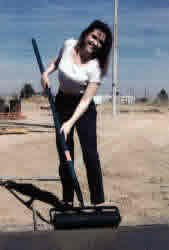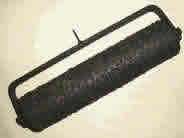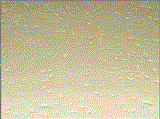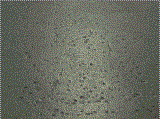- Staining Concrete
- Stamped Concrete
- Concrete Overlays
- Concrete Resurfacing
- Concrete Polishing
- Concrete Dyes
- Colored Concrete
- Indoor Concrete
- Concrete Floors
- Concrete Countertops
- Garage Floor Coatings
- Furniture, Sinks, Fire Bowls
- Basement Floors
- Outdoor Concrete
- Concrete Patios
- Concrete Driveways
- Concrete Pool Decks
- Outdoor Kitchens & Counters
- Outdoor Fireplace
- Concrete Walkways
- Concrete Pavers
- Concrete Walls
- Repair & Maintenance
- Foundation Repair
- Concrete Crack Repair
- Concrete Sealers
- Building with Concrete
- Concrete Homes
- Concrete Basements
- Decorative Concrete
Concrete Stamp Roller
Salt Finish Without the SaltA popular textured finish for concrete flatwork, particularly in the western and southern regions of the country, is a rock-salt finish. As the name implies, the look is traditionally achieved with the same coarse rock salt sold for use in water softeners or as a deicer in winter. Concrete finishers broadcast the salt particles over wet concrete and then press the grains into the surface with a float or roller. After the concrete sets, they power wash the salt away, revealing a speckled pattern of shallow indentations left by the dislodged salt particles.
Although the process sounds simple enough, it can be very time consuming. Certainly too time consuming for Bob Zieger, a concrete contractor in Arizona who invented an easier, faster, and salt-free way to achieve the same look.
Bob has installed miles of salt finish in Arizona, says his wife Michele. On some jobs, the heat caused problems with the concrete setting too fast. By the time hed get to the end of the job, the concrete was already hard and he could no longer tap the salt in.
Bobs solution was to devise a roller with nubs that would precisely duplicate the indentations left by the rock salt, but in much less time. He worked on a prototype roller for over a year before coming up with a model that produced the realistic results he was after. His patented Salt Roller debuted at World of Concrete in 1998, and he and Michele now sell the tool worldwide through their company Simple Solutions, based in Chandler, Ariz.
The all-steel roller comes in two lengths: a 15-inch model for fast imprinting of large surface areas and a 7-inch margin roller that can work close to walls, steps, and form edges. Both models adapt to snap-on or screw-on handles. Without the handle, the 15-inch roller weighs only 7 pounds and the smaller margin roller only 4 pounds. We experimented with different lengths, widths, and weights to determine what works best, says Michele. The roller doesnt need a lot of weight because you only want the nubs, not the drum, to sink into the concrete.
Because the Salt Roller is so lightweight, one person can easily use it to complete an entire joband in about a quarter of the time required by the traditional method. The tool saves time by eliminating the tedious steps of scattering salt evenly over the surface and working it in. Whats more, crews dont have to return the next day, after the concrete has set, to wash away the salt. (This dissolved salt can also harm plants and grass, notes Michele.)
Very little training or practice is required to use the roller. It works just like a concrete stamp leaving an impression in the concrete surface. It will not leave seam lines, so finishers can roll out their passes in any direction they desire. Rolling over a previous pass will not affect the pattern. And because the roller drum itself has negligible contact with the wet concrete, no release agents or plastic are needed to prevent the concrete from sticking. For jobs where deep indentations are desired, the drum can be coated with a nonstick cooking spray to ensure a clean release.
That leads to another advantage of the Salt Roller: It can achieve various indentation depths, depending on the firmness of the concrete at the time of rolling. The spacing and diameter of indentations can be varied as well. We have some customers who want a sparse salt spacing. We ask them how many inches they want between the impressions and if they want large salt or small salt, and we manufacture what they want, says Michele.
The roller also adds to the aesthetics of a salt finish by allowing contractors to apply the finish to colored concrete without concern for staining. One problem with the traditional rock-salt method is that the salt particles would leave rings on colored concrete, Michele explains. The roller can even be used on decorative overlays, as long as they are at least 1/8 inch thick.
In the four years that Simple Solutions has been selling the Salt Roller, the most popular applications have been for residential flatwork, especially driveways, sidewalks, patios, and pool decks. And the finish definitely has a strong regional appeal. Our biggest markets are Phoenix, the Las Vegas area, California, and Florida, says Michele.
However, she is beginning to see the demand for their Salt Roller creep northward, despite the concerns some contractors have had in the past about the potential for spalling of salt finishes in freeze-thaw climates. We have sold the roller throughout Canada, New York State, Michigan, Ohio, and other areas subject to freezing weather, and not one customer has encountered a problem with spalling. Though the roller does not produce a cone-shaped hole, the hole is more open at the top so it doesnt trap in moisture.
Although the Salt Roller was originally designed for use on flatwork, a few users are dreaming up creative ways to use the tool on vertical surfaces. We manufactured a roller with a thinner-gauge drum for one customer who wanted to use it on stucco. He rolled it over the undercoat so the topcoat would adhere better, says Michele. Another customer used the roller on a cementitious coating applied to insulating block forms to achieve a stucco-like texture.
Simple Solutions sells the Salt Rollers individually or as a set (7-inch and 15-inch), and offers a lifetime warranty on the product. The company says that a set of rollers (about $260) can easily pay for itself on the first job when you factor in the savings in time and labor.
A testimonial page on the Simple Solutions web site seems to support that claim. The contractors listed on that page approached us and wanted to let us know that they love the rollerit saved them a ton of money, says Michele.
For more information:
Simple Solutions
P.O. Box 8197
Chandler, AZ 85246-8197
877-725-8765
www.saltrollers.com
Anne Balogh writes feature articles each month for The Concrete Network. She is a freelance writer based in Glen Ellyn, Ill., and a former editor of Concrete Construction magazine.








